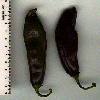
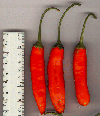
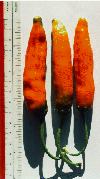
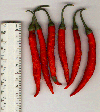

The pods in the first picture are Aji Panca from The Pepper Gal grown by Lynn Edwards.
The next two pictures are the aji amarillo (yellow) cultivar. The last two are the red cultivar. Grown by Brent Thompson in San Jose, CA.
A lowland species found up to 1,100 m elevation. It is a tall (3-6 feet) sprawling shrub; flowers have white corolla with 2 yellow spots at the base of each petal; fruits pungent. It requires a long growing season (over 120 days) as it is slow to begin flowering. This species has nearly as many cultivars as C. annuum, with much variation in size, shape, and color (which can be yellow, orange, brown, and red). Aji's have a fruity flavor.
30,000-50,000 Scoville Heat Units.
Used in ceviche and salsas. Also dried and used as chile powder.

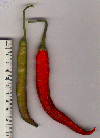
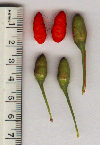
From left: Chapeu-de-Frade, Kovinchu, Portachuela. Grown by Brent Thompson
in San Jose, CA.
30,000-50,000 Scoville Heat Units
Dried, and powdered, or crushed into flakes. Many Louisiana hot sauces use cayennes.
The first picture is a typical habanero; the second is a photo of the 'Red Savina' cultivar. The next two pictures are my 'goat' peppers -- they start out very light green, then turn to red rather than orange. The fifth is a Rocotillo pepper; Jean Andrews calls it her favorite eating pepper.
0 - 325,000 Scoville Heat Units; most habaneros run in the 150,000 range; the Red Savina was measured at 325,000.
Fresh in salsas; pickled or made into hot sauces, typically mixed with onion and carrots.
 This is a Scotch Bonnet pepper, most likely a different cultivar from the
habanero. These ripen from green to yellow. Pepper grown by Rich Pearlstein
in Delaware.
This is a Scotch Bonnet pepper, most likely a different cultivar from the
habanero. These ripen from green to yellow. Pepper grown by Rich Pearlstein
in Delaware.
 Ojemma peppers (not sure of the spelling) are a very nice C. chinense cultivar
grown widely in Ghana. It has a nice flavor and heat, but not as good tasting
as the Scotch bonnet. However, it is VERY prolific and high yielding, germinates
readily, and bears early in the season, none of which are typical of Scotch
bonnet! Also it seems immune to TMV unlike the other varieties I have grown.
The Ojemma comes true to seed in my experience, even when open-pollinated.
Rich Pearlstein -- richie@marlin.ssnet.com
Ojemma peppers (not sure of the spelling) are a very nice C. chinense cultivar
grown widely in Ghana. It has a nice flavor and heat, but not as good tasting
as the Scotch bonnet. However, it is VERY prolific and high yielding, germinates
readily, and bears early in the season, none of which are typical of Scotch
bonnet! Also it seems immune to TMV unlike the other varieties I have grown.
The Ojemma comes true to seed in my experience, even when open-pollinated.
Rich Pearlstein -- richie@marlin.ssnet.com
 Pimenta de Cheiro, grown by John Moore in Melbourne, Austraila. This is
one of the two main culinary chiles used in Brazil.
Pimenta de Cheiro, grown by John Moore in Melbourne, Austraila. This is
one of the two main culinary chiles used in Brazil.
The name pimenta de cheiro means (roughly) "scented chile", and it is used as much for its taste as for its heat. It is also called "pimenta arriba saia", which refers to the women raising their skirts to fan their faces because of the heat of the food. It is, I believe, C. chinense, and looks very much like habanero, from the photos I have seen of habaneros. Pimenta de Cheiro is larger [than a habanero plant] with even darker green leaves which are smooth rather than crinkled like the others. Itis actually quite a handsome plant with its deep green foliage and rich orange fruit.
Pimenta de cheiro is used whole in a small number of casserole/stew type dishes, such as Sarapatel, sometimes called the Brazilian haggis, made from offal, blood, pimenta de cheiro and a few other things.
 Aji Yuquitania; grown by Brent Thompson in the San Francisco Bay area.
Aji Yuquitania; grown by Brent Thompson in the San Francisco Bay area.
Aji Yuquitania (C. chinense), is from the Cubeo Indians, Mitu region, Dept. Vaupes, Colombia. It is extremely pungent, reputedly much more so than habanero (difficult to tell at that heat level, but my taste tests haven't yet contradicted that reputation).
Flavor similar to habanero and most other C. chinense, though different of course. Flavor a bit milder than habanero -- I think I prefer its flavor over habanero, and at least one of my test victims definitely does. Unfortunately, I have not yet succeeded in getting any known-to-be-self-pollenized fruits, so am getting worried about prospects for the future.
The first picture shows the typical green jalapeños, which ripen to red (second picture).
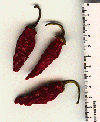

These two picture are of smoked jalapeños, known as chipotles. The first picture is a home-smoked jalapeno from my garden, the second is 2 chipotle mecos bought in "La Merced" --the most important flea market in Mexico City, certainly a place to visit by a chile lover-- and they are good quality. Chipotle Meco scanned by Daniel M. German
2500-10,000 Scoville Heat Units
Fresh in salsas; pickled. Can be frozen well, but don't dry well since they are too thick. Ripe (red) jalapeños are smoked and then called chipotles.
Jalapa and TAM Jalapeño are milder than the standard variety
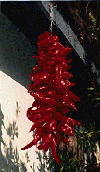 This is a ristra,
a string of red chiles.
This is a ristra,
a string of red chiles.
 This is a picture of some pepper plants with one of the mosaic viruses.
TMV (tobacco mosaic virus) is a common one which can be spread by smokers.
Wash your hands before gardening!
This is a picture of some pepper plants with one of the mosaic viruses.
TMV (tobacco mosaic virus) is a common one which can be spread by smokers.
Wash your hands before gardening!

 This is a photo of one of my New Mex Twilight pepper plants. This is an
ornamental pepper. It grows about 2 ft high, and is great in containers.
The second photo is of the pods. They start out yellow, then turn purple,
orange and red, and are about 1" long.
This is a photo of one of my New Mex Twilight pepper plants. This is an
ornamental pepper. It grows about 2 ft high, and is great in containers.
The second photo is of the pods. They start out yellow, then turn purple,
orange and red, and are about 1" long.
 NuMex Centennial. Another ornamental pepper plant developed at New Mexico
State. Similiar to the Twilight's above. Pods ripen from purple -> cream
-> orange -> red. Compact plants. Grown by Lynn Edwards in the SF
Bay area.
NuMex Centennial. Another ornamental pepper plant developed at New Mexico
State. Similiar to the Twilight's above. Pods ripen from purple -> cream
-> orange -> red. Compact plants. Grown by Lynn Edwards in the SF
Bay area.
 Pretty Peruvian Purple. A very nice looking plant. Mostly green, but with
lots of purple highlights. Pods start out green, and ripen to red then
purple.
Pretty Peruvian Purple. A very nice looking plant. Mostly green, but with
lots of purple highlights. Pods start out green, and ripen to red then
purple. The first two pictures are of the variety NexMex Joe Parker, grown in Davis, CA. The third and fourth pictures are NewMex Big Jim peppers, grown in Los Lunas, NM and Hatch, NM respectively, courtesy of Rick Myers. The peppers in the fifth picture are dried NewMex Joe Parkers. The last two are varieties usually grown for ornamental ristras: NuMex Sunrise (yellow) and NuMex Sunset (orange) (grown by Lynn Edwards).
500-2500 Scoville Heat Units
Green: roast,
peel and use for salsa, sauces (especially chile verde) or stuff with cheese,
shrimp or various spiced meat/vegetable mixtures, or freeze.
Red: dry
in the sun or make
a ristra, dried chiles can be used for red chile sauces or ground into
chile powder. 
Anaheim, New Mex 6-4, New Mex Big Jim, New Mex Joe Parker, Sandia (hot!) Chimayo, Española, NuMex Sunrise, NuMex Sunset

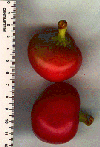
Cherry peppers, because they look like cherries! Heat ranges from 0 to 3500 Scoville Heat Units. Red or orange when ripe. Nice looking ornamental plant. Ususally found pickled. The pods in the first picture came from a local farmer's market; they're a sweet cherry pepper. The larger pods in the second picture were grown by Lynn Edwards and are the Hot Cherry variety from Plants of the Southwest.

Here's some Chiltepin peppers that were grown in Mexico. These are wild peppers, sometimes called Tepin, Bird, or Bird's Eye peppers. The seeds need to pass through the digestive tract of a bird before they will germinate. Heat is similar to a Serrano, but varies quite a bit. They have subtle flavor, and are good to use in soups, stews or sauces.
Rick Myers -- rcm@col.hp.com
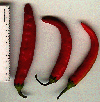
Similar looking to cayenne, but not related. Smaller, 2-3" long with a distinctive flavor. Hot, between 15,000 and 30,000 Scoville Heat Units. Large plants, forming a multi-branching tree shape. Used red or dry, primarily in sauces. The pictured chiles were grown from De Arbol peppers, but probably are a cross since they are somewhat larger.
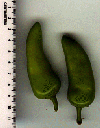
The Fresno variety originated in Fresno, CA, in 1952 by the Clarance Brown Seed Co. Andrews suggests it is a TMV resistant cross between serranos and one of the long green New Mexico type peppers. Medium hot, probably around 5,000-15,000 Scoville Heat Units. I've used them for stuffing, salsas, and to add more heat to green chile sauce.

I don't know too much about these, but they are used in a number of Mexican dishes and are common there. DeWitt and Bosland classify them with the mirasol pod type in The Pepper Garden. Other Mirisol varieties include Cascabel. 2500-5000 Scoville Heat Units. These are about 4-6" long. Usually dried and ground for chile powder, or used fresh in salsas.

Commonly found in Mexico. I picked these up at a chili (the red meaty stuff) festival. Güero means 'blond' in Spanish; ie, the peppers are yellow when mature. They have a nice, spicy smell to them.

Picked up at the farmer's market in Sacramento. The grower called them "muta" or maybe "mufa". He said they were hotter than seranno, but not as hot at the red chiles he was selling. They are similar in size and shape to pasilla's, but are much hotter and not as wrinkled or seedy.
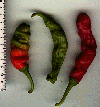
Also called penis pepper due to it's shape. Ranges from 3" to 7". Ripens to red. Hot. Grown by Lynn Edwards.

My next door neighbor grows these -- They start out very dark purple, then turn red when ripe. I ate a bit of one last year, said "These aren't very hot", then took a lager bite -- WOW! Just as hot as Thai peppers. Just under 1", and more egg-shaped than elongated. He tells me they're called something like "Pretty Purple Peruvian Peppers". Seeds of Change sells something like these; they call them a C. frutescens.
The pepper on the left is one of my "Pasilla Apaseo" that I grew in 1994. The one on the right is a dried pasilla negro found by Rick Meyers in a store in Albuquerque, for $5.99/lb.
1000-1500 Scoville Heat Units.
Dried pods used for mole sauces, fresh can be used in enchilada and chile sauces. Diana Kennedy has a great sauce consisting of 3-4 toasted dried pods, 1 Tbs salt and a few garlic cloves chopped up in 1/2 cup of water. Put two tablespoons in a heated pan for a few seconds, then throw in two scrambled eggs. Serve over heated tortilla, top with ranchero cheese. Great!
0 Scoville Heat Units (no heat)
Canned and used to stuff olives. Used fresh like bell peppers. Can be pickled or dried and used for paprika.
The first picture is a poblano grown here in Davis, CA. The second is a scanned photo of another pod; it has better contrast. The third picture is one of the Ancho-101 commercial variety. The next picture is several dried poblano peppers, now called ancho chiles. The last picture is an Ancho Mulato, bought in Albuquerque by Rick Meyers. Mulato's are poblano's that turn black or dark brown when ripe.
1000-1500 Scoville Heat Units
Green: roast, peel and use for salsa, sauces (especially chile verde)
or stuff with cheese, shrimp or various spiced meat/vegetable mixtures,
or freeze.
Red: dry in the sun; dried chiles can be used for red chile sauces or ground
into chile powder for use in moles. The traditional mole has ancho,
mulato and pasiila chiles.
Ancho-101, Poblano Mulato
The first photo is Rocoto from The Pepper Gal grown by Lynn Edwards.
*The only Chile with black seeds. Also called Rocoto (Peru), Locoto (Bolivia), chile Manzano and chile Peron (Mexico). This is the most common chile found in the Andes. Flowers are purple with some white, leaves and stems are strongly pubescent (hairy), and the seeds are dark brown or black rather than yellow or white. It requires a long cool frost-free growing season (120+ days), preferring temperatures of 40-60 degrees F. (therefore they do better in the shade for most of us). The plants will grow 10+ years and get up over 10 ft. tall if not subjected to frost or extreme summer heat. Pods mature to yellow. Fruit is very fleshy and seed core is quite separate from the flesh, rather like a small, pungent, delicious bell pepper. Some palates consider them much hotter than Habaneros due to the unique mix of capsaicins.
Pods mature to red, yellow, orange, or brown. Fruit is very fleshy and seed core is quite separate from the flesh, rather like a small, pungent, delicious bell pepper. Some varieties seem much hotter than habaneros due to the unique mix of capsaicins.
30,000-60,000 Scoville Heat Units.
Usually eaten fresh in salsas or stuffed and baked.
Pods in the first picture courtesy of Rich Perlstein; those in the second courtesy of Lynn Edwards.
30,000-50,000 Scoville Heat Units.
Used for vinegar based sauces, or spicy Asian dishes.
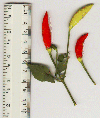
 These are from a plant which was given to me as C. chacoense, but which
is actually C. frutescens [12Nov94] -- probably in fact some wierd pointy
type of tabasco:
These are from a plant which was given to me as C. chacoense, but which
is actually C. frutescens [12Nov94] -- probably in fact some wierd pointy
type of tabasco:
Decidous (and hardy) in winter in San Francisco Bay area; long, erect peduncle with flower nodding from a sharp bend within 1/2" from the end, green corolla; fruits red-orange, sharply tapered, 1.5" long x 1/4" wide, pungent. Very drought tolerant.
Brent Thompson -- brent@hplbct.hpl.hp.com
2500-10,000 Scoville Heat Units
Fresh chiles are used in salsas; many wax peppers are pickled.
Pretty mild
These are the typical commercial pickled peppers.
 Szentesi peppers. Early, ripen in 60 days. Hungarian Medium Hot. Lime green
tapered, pendant 4 1/2 inch/11cm fruit ripen green yellow/yellow/orange.
Exclusive to Stokes seed company.
Szentesi peppers. Early, ripen in 60 days. Hungarian Medium Hot. Lime green
tapered, pendant 4 1/2 inch/11cm fruit ripen green yellow/yellow/orange.
Exclusive to Stokes seed company.
These particular peppers were one of my favorites. They are very prolific, hot (but not too hot for mass consumption), stuff well, and most importantly produce hot fruit early in the season when many other 'hot' varieties are still too mild (like bell peppers). The Szentesi plants are still loaded with fruit in mid-October in northern California.
Lynn EdwardsHungarian Wax is the most common; many others are mild or have no heat.
If you have an idea what varieties any of these peppers might be, please email me. Thanks.
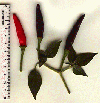
My friends know I've always been a Chile-head, so last October one of them gave me a bag of these bright red, pretty as can be peppers, which he got from a Vietnamese girl he's just met. Her mom apparently grows the plants.
I planted them in the garden in May, I think. Now they're nice and big, the tallest one being about 4 feet tall, and each of them has about 60, 70 pods, with many flowers still in bloom. The pods start out green, then turn purple/black on the sides exposed to the sun. On a couple of plants, the most exposed, the pods are totally black, it actually looks pretty neat, and they are all sticking straight up in the air. The flowers are white, with 5 petals, and no spots. The seeds are yellow, not black at all. I have tasted one of the red pods, and it is very hot, though not as hot as I remember the original ones to be..(but then I've tasted habs since then, so I may be off somewhat here). The pods go from purple/black to red, with no orange phase in between.
David -- dqle@netcom.com

They are hot, and interesting looking -- they tend to curl up like the one on the right. Are they some kind of thai cross?.